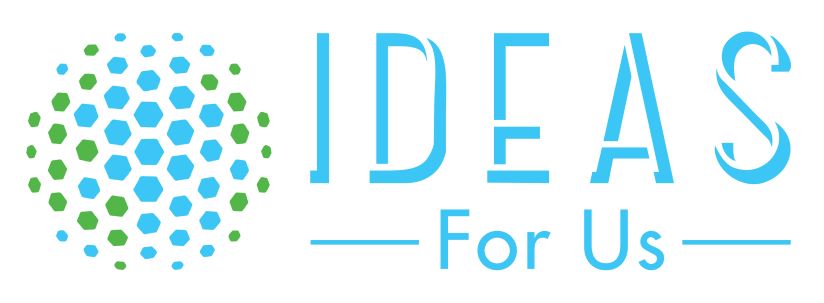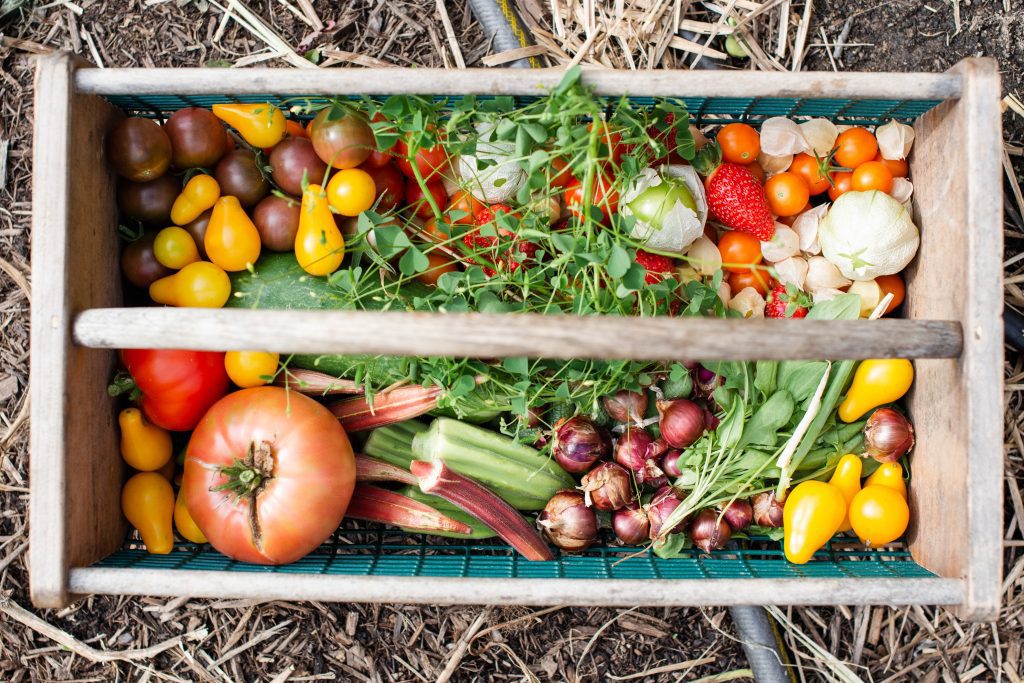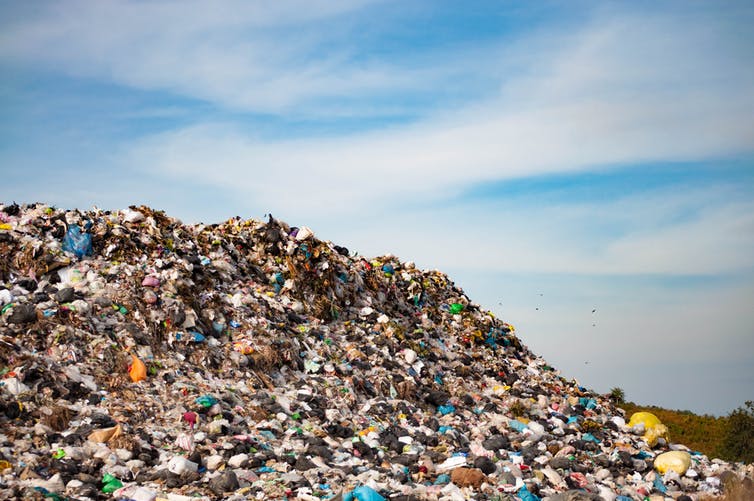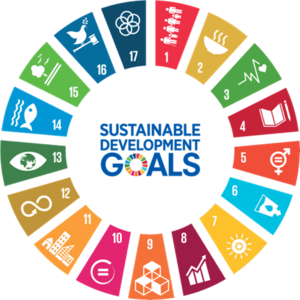On November 19th, 2021, the House passed the Build Back Better Act (BBBA) with a close 220 to 213 vote.1 Now that the BBBA is onto the Senate, let’s look at what the bill contains for fighting the climate crisis as it proposes a total of $555 billion in clean energy and climate investments.2

PHOTO FROM UNSPLASH/MARKUS SPISKE
The symbol that appears in the poster is the extinction symbol, as the “hourglass inside serves as a warning that time is rapidly running out for many species….and this symbol is intended to help raise awareness of the urgent need for change in order to address this crisis.”3
It is known that in the next 20 years, a 1.5°C increase in global-mean surface air temperature (GSAT) is likely to occur and the likelihood that the GSAT exceeds 1.5°C by 2030 (in any individual year) is between 40% and 60%.4 To limit global warming a cumulative CO2 emission limit is needed, net-zero CO2 emissions need to be reached, and other greenhouse gas emissions like CH4 and Methane need to be reduced too.5 The Build Back Better “framework will set the United States on course to meet its climate targets, achieving a 50-52% reduction in greenhouse gas emissions below 2005 levels in 2030 in a way that grows domestic industries and good, union jobs — and advances environmental justice.”2
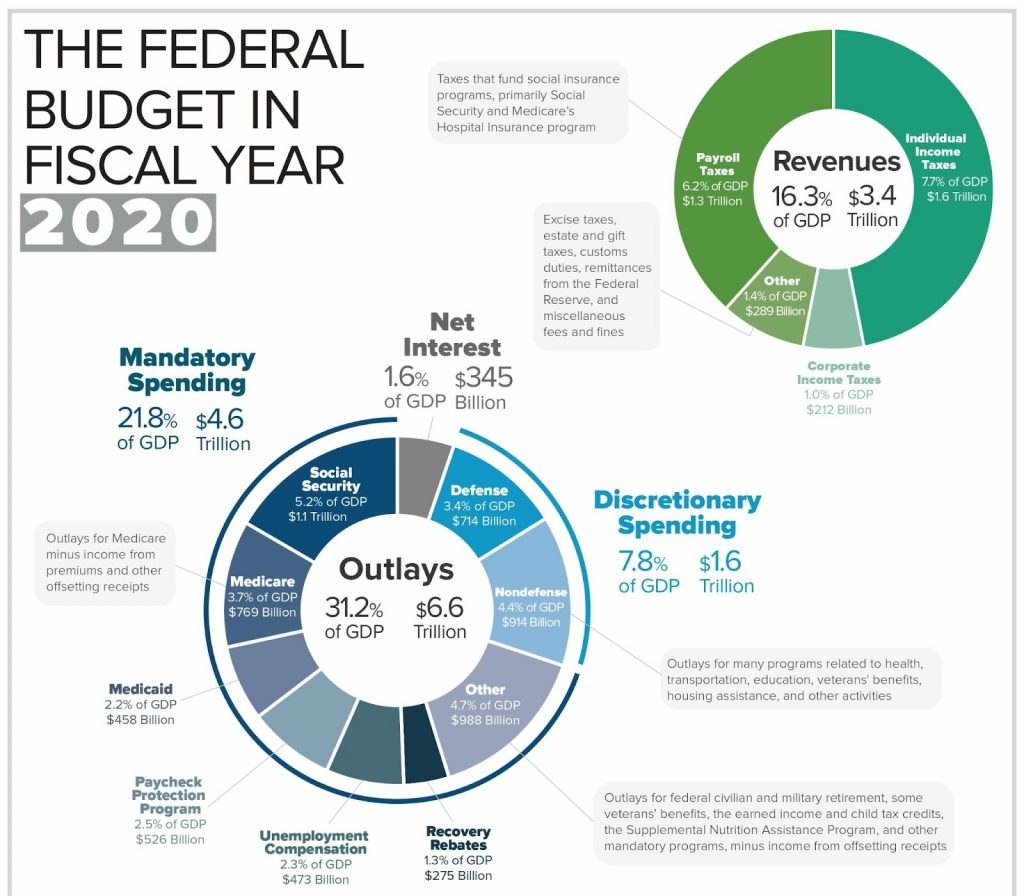

TOP TO BOTTOM: FROM THE CONGRESSIONAL BUDGET OFFICE,6 FROM THE CONGRESSIONAL BUDGET OFFICE.7
Looking at the federal budget in the 2020 fiscal year, we see nondefense environmental and natural resource, general science, and energy spending as just a portion of $129 billion labeled “other” in discretionary spending; in comparison, defense spending is $714 billion.7 The BBBA would be -if passed- would be the United States’ largest climate investment in its history as it funds more than 130 different areas “in climate and environmental justice.”8
Clean Energy and Manufacturing
The BBBA provides funding for job placement and career services, energy-efficiency projects, electric vehicles, and zero-emission, heavy-duty vehicles.9 A methane fee for certain petroleum and natural gas facilities is also established by the bill.9
There are multiple provisions related to clean energy in the BBBA, here are just some of them. In the section, Clean Energy Repowering For Rural Utilities, $9,700,000,000 is allocated for (and available until September 30, 2031) creating grants and loans to purchase and deploy renewable energy/renewable energy systems, and make energy efficiency enhancements after the BBBA is enacted; plus “grants for debt relief and other costs associated with terminating, after the date of enactment of this Act or up to one year prior to the date of enactment, the use of (A) facilities with high greenhouse gas emissions; and (B) related transmission assets.”10 There is also $70,000,000 (remaining until September 30, 2026) allocated to the Office of Energy Efficiency and Renewable Energy to conduct activities to support a new Clean Energy Manufacturing Innovation Institute.10 In 2016, the ninth institute in the Manufacturing USA network, the Clean Energy Smart Manufacturing Innovation Institute (CESMII) was initiated; the institute works on the research and development of technologies expected to greatly improve process control and operation with the benefits of improved “energy efficiency, equipment reliability, productivity gains, as well as related improvements in safety, quality, and yield in manufacturing processes.”11
In the section, Biofuel Infrastructure and Agriculture Product Market Expansion, there is the allocation of $960,000,000 (remaining until September 30, 2031) to provide grants for installing/adding/upgrading fuel-related equipment (dispensers, pumps, storage tank system parts, etc.) and for building and adding components to ethanol and biodiesel distribution systems, including home heating oil distribution.10 Biodiesel is renewable and biodegradable, produced from domestic “vegetable oils, animal fats, or recycled restaurant grease.”12 100% biodiesel (B100) emissions are 74% lower petroleum diesel emissions.12 Biodiesel and ethanol are both biofuels, renewable fuels that are created from “biomass converted directly into liquid fuels.”13
In the section, Conveyance Repairs and Build Back Better Funds for Solar Canal Integration, $100,000,000 is allocated (remaining until September 30, 2031) “for the design, study, and implementation of projects”10 using solar panels to cover water conveyance facilities. Suspending solar panels over water canals can both shade and conserve the water in the canals and cool the solar panels above.14 The surface area that solar panels ideally cover are not land that can be used for agriculture.15 Covering 4,000 miles of California’s water canals can save “63 billion gallons of water annually, which is comparable to the amount needed to irrigate 50,000 acres of farmland.”16 In the section, Department of Energy Research, Development, and Demonstration Activities, $1,107,500,000 is allocated to the Department of Energy Office of Energy Efficiency and Renewable Energy (remaining until September 30, 2026) to perform demonstration projects of wind energy technologies, solar energy technologies (including technologies for the domestic production of solar supply chain materials), geothermal technologies, water power technologies, vehicle technologies, bioenergy technologies, and building technologies.10
“The average homeowner will find it $7,000 cheaper to install solar on their roof as wind and solar power expand into our communities at more than twice the current speed.”8
In the section, Electric Vehicle Supply Equipment Rebate Program, $2,000,000,000 is allocated to establishing and executing a rebate program “to provide rebates to eligible entities for covered expenses associated with electric vehicle supply equipment located at workplaces, multi-unit housing structures, and publicly accessible locations”10 (disbursements will not continue after September 30, 2031). Rebate amount proposed for new electric vehicle supply equipment at those locations would be the lesser of 75% of the covered expenses, $1,000 for covered expenses of the purchase and installation of non-networked level 2 charging equipment, $4,000 for covered expenses of purchase and installation of networked level 2 charging equipment, or $100,000 for covered expenses of purchase and installation of networked direct current fast-charging equipment.10 The rebate amount for replacement equipment of pre-existing electric vehicles would be the lesser of 75%, $500, $2,000, or $35,000 respectively.10
Preservation and Conservation
The bill provides funding for the management of the National Forest System, wildfire prevention, drought relief, conservation efforts, and climate change research.9
In the section, National Forest System Restoration and Fuels Reduction Projects, $10,000,000,000 is allocated to hazardous fuels reduction projects “within the wildland-urban interface”10 (remaining until September 30, 2031). The wildland-urban interface (WUI) refers to the area or zone where unoccupied land, undeveloped wildland, or vegetative fuels and human development meet.17
“more than 46 million residences in 70,000 communities in the United States are at risk for WUI fires.”18
$4,000,000,000 is allocated to projects that are not in the WUI that are noncommercial -but if merchantable materials need to be collected is out of ecological necessity, “for restoration and to enhance ecological integrity”10 – and developed collaboratively. The execution of the projects should strengthen ecological integrity and work to restore the forest ecosystems, “maximizes the retention of old-growth and large trees,”10 and uses prescribed fire to modify wildland fire behavior. $1,000,000,000 is allocated to vegetation management projects on National Forest System lands, “$350,000,000 for National Forest System land management planning and monitoring”10 focusing on watershed, ecological, and carbon conditions, and revising older land management plans for additional ecological protection, maintenance, and restoration. $200,000,000+ can be found in the bill for various National Forest System land maintenance.10 There is $50,000,000 for development and execution of tactics to protect mature forests on National Forest System land, and $50,000,000 to develop and execute tactics to maintain and restore “habitat conditions necessary for the protection and recovery of at-risk species on National Forest System land in implementing Forest Service hazardous fuels reduction and other vegetation management programs and projects.”10 The bill allocates $2,250,000,000 to the development of a Civilian Climate Corps (including funding for staffing, salaries, etc.) used to help manage National Forest System land.10
The BBBA would “create more than 300,000 good jobs in a new Civilian Climate Corps that helps communities clean up pollution and adapt to climate change.”19
The BBBA also includes provisions for sustainable agriculture. In the section, Department of Agriculture Research Funding, $250,000,000 (remaining until September 30, 2031) is allocated to the Agricultural Research Service to execute agricultural research related to climate change, “including through climate hubs, long-term agroecosystem research, nutrient uses, and outcomes, soil carbon data collection, and other related agricultural climate science.”10 100,000,000+ is provided for agricultural economic analysis, economic research, and data relating to climate change to the Economic Research Service, the Office of the Chief Economist, and the National Agricultural Statistics Service.10 For the National Institute of Food and Agriculture to execute agricultural education, extension, and research related to climate change, $50,000,000+ is allocated to each of the 2022 and 2023 fiscal years, and $300,000,000+ for 2024 to 2026 fiscal years.10 $2,664,500,000 is allocated to the 2022 fiscal year “for grants for construction, alteration, acquisition, modernization, renovation, or remodeling of agricultural research facilities.”10
Environmental Justice
The BBBA includes funding for safe drinking water projects, weatherization projects, tribal infrastructure programs, and transit services, and clean energy projects for low-income communities.9
In the section, Lead Service Line Replacement, $30,000,000,000 is allocated to “full lead service line replacement projects and associated activities directly connected to the identification, planning, design, and full replacement of lead service lines”10 under the Safe Drinking Water Act and $20,000,000,000 of it would be shall be for subsidies in “the form of loans, with 100 percent forgiveness of principal, or grants”10 for disadvantaged communities. $420,000,000 is allocated for grants to install and maintain lead filtration stations at schools and child care programs.10 In the section, Grants For Indian Reservation Drinking Water Infrastructure, $100,000,000 is allocated to implementing eligible projects.10 In the section, Assistance For Disadvantaged Communities, $200,000,000 is allocated to grants under the Safe Drinking Water Act; In the section, Grants For Contaminant Monitoring, $100,000,000 is allocated to monitoring costs grants.10
“One NRDC analysis found that between 2018 and 2020, 56 percent of the U.S. population drank from water systems with detectable levels of lead.”20
The BBBA also includes provisions for drought relief, including $1,000,000,000 (remaining until September 30, 2026) allocated for near-term drought relief measures.10 In the section, Emergency Drought Relief For Tribes, $150,000,000 (remaining until September 30, 2026) is for near-term drought relief measures and mitigation for drought impacts on Native American Tribes “that are impacted by the operation of a Bureau of Reclamation water project, including through direct financial assistance to address drinking water shortages and to mitigate for the loss of Tribal trust resources.”10
In the section Weatherization Assistance Program, $850,000,000 is allocated to providing financial assistance to apply measures that make housing units lived in by low-income individuals are “weatherization-ready.”10 The Weatherization Assistance Program is the Department of Energy’s program that works to decrease “energy costs for low-income households by increasing the energy efficiency of their homes, while ensuring health and safety.”21
“Low-income households carry a larger burden for energy costs, typically spending 16.3% of their total annual income versus 3.5% for other households.”22
In the section, Electric Vehicle Charging Equity Program, $1,000,000,000 (remaining until September 30, 2031) to create the EV Charging Equity Program and execute it: provide technical assistance to eligible entities and award grants to eligible entities “for projects that increase deployment and accessibility of electric vehicle supply equipment in underserved or disadvantaged communities.”10 These projects would be publicly accessible and be accessible to public or affordable housing residents, residents of multi-unit dwellings, and single-family homes.10
The Build Back Better Act will put the United States on the right track towards reducing our greenhouse gas emissions and working toward the Paris Agreement’s goals of limiting “global warming to well below 2, preferably to 1.5 degrees Celsius, compared to pre-industrial levels.”23
What You Can Do
Get in touch with your senators by calling: text “History” to 434-266-8464.
IDEAS For Us supports the Build Back Better Act and if you want to help urge your elected officials to vote in favor of the BBBA, find your US Senators and their contact information at https://www.senate.gov/senators/senators-contact.htm. Feel free to copy this message:
Dear Senator [INSERT YOUR SENATOR],
As a [YOUR STATE] resident, I’m getting in touch to express my support for the Build Back Better Act (BBBA). The BBBA would create thousands of jobs with the Civilian Climate Corps, increase electric vehicle accessibility, grow clean manufacturing, replace lead water system lines, provide drought relief, work to reduce fires in wildland-urban interface, and much more that I would be hopeful to see. The BBBA will put the United States on the right track towards reducing our greenhouse gas emissions and working toward the Paris Agreement’s goals of limiting global warming to below 2 degrees Celsius above pre-industrial levels.
Sincerely,
[YOUR NAME]
For Florida Residents
Visit for why Florida needs the Build Back Better Act: https://climatepower.us/resources/why-florida-needs-climate-action-now/
Register to vote in for the 2022 Florida gubernatorial election and the 2022 Florida US Senate election on Nov. 8th and the : https://registertovoteflorida.gov/home
Sources
- “Actions – H.R.5376 – 117th Congress (2021-2022): Build …” Actions Overview H.R.5376 — 117th Congress (2021-2022), 2021, https://www.congress.gov/bill/117th-congress/house-bill/5376/actions.
- “President Biden Announces the Build Back Better Framework.” The White House, The United States Government, 1 Nov. 2021, https://www.whitehouse.gov/briefing-room/statements-releases/2021/10/28/president-biden-announces-the-build-back-better-framework/.
- “Extinction Symbol.” Extinction Symbol, https://www.extinctionsymbol.info/.
- Chapter 4, IPCC, 2021: Climate Change 2021: The Physical Science Basis. Contribution of Working Group I to the Sixth Assessment Report of the Intergovernmental Panel on Climate Change Lee, J.-Y., J. Marotzke, G. Bala, L. Cao, S. Corti, J.P. Dunne, F. Engelbrecht, E. Fischer, J.C. Fyfe, C. Jones, A. Maycock, J. Mutemi, O. Ndiaye, S. Panickal, and T. Zhou: 2021, Future Global Climate: Scenario-Based Projections and Near-Term Information. In Climate Change 2021: The Physical Science Basis. Contribution of Working Group I to the Sixth Assessment Report of the Intergovernmental Panel on Climate Change [Masson-Delmotte, V., P. Zhai, A. Pirani, S.L. Connors, C. Péan, S. Berger, N. Caud, Y. Chen, L. Goldfarb, M.I. Gomis, M. Huang, K. Leitzell, E. Lonnoy, J.B.R. Matthews, T.K. Maycock, T. Waterfield, O. Yelekçi, R. Yu, and B. Zhou (eds.)]. Cambridge University Press. In Press. https://www.ipcc.ch/report/ar6/wg1/downloads/report/IPCC_AR6_WGI_Chapter_04.pdf.
- IPCC, 2021: Summary for Policymakers. In: Climate Change 2021: The Physical Science Basis. Contribution of Working Group I to the Sixth Assessment Report of the Intergovernmental Panel on Climate Change [MassonDelmotte, V., P. Zhai, A. Pirani, S.L. Connors, C. Péan, S. Berger, N. Caud, Y. Chen, L. Goldfarb, M.I. Gomis, M. Huang, K. Leitzell, E. Lonnoy, J.B.R. Matthews, T.K. Maycock, T. Waterfield, O. Yelekçi, R. Yu, and B. Zhou (eds.)]. Cambridge University Press. In Press. https://www.ipcc.ch/report/ar6/wg1/downloads/report/IPCC_AR6_WGI_SPM.pdf
- The Federal Budget in Fiscal Year 2020, Congressional Budget Office, 2021, https://www.cbo.gov/system/files/2021-04/57170-budget-infographic.pdf.
- Discretionary Spending in Fiscal Year 2020, Congressional Budget Office, 2021, https://www.cbo.gov/system/files/2021-04/57172-discretionary-spending.pdf.
- Zuckerman, Morissa. Build Back Better Act: Out of the House, On to the Senate, Sierra Club, 19 Nov. 2021, https://www.sierraclub.org/articles/2021/11/build-back-better-act-out-house-senate.
- “Summary: H.R.5376 — 117th Congress (2021-2022).” H.R.5376 – Build Back Better Act, 2021, https://www.congress.gov/bill/117th-congress/house-bill/5376.
- “Text: H.R.5376 — 117th Congress (2021-2022).” H.R.5376 – Build Back Better Act, 2021, https://www.congress.gov/bill/117th-congress/house-bill/5376/text.
- “Clean Energy Smart Manufacturing Innovation Institute (CESMII).” Energy.gov, https://www.energy.gov/eere/amo/clean-energy-smart-manufacturing-innovation-institute-cesmii.
- “Biodiesel Fuel Basics.” Alternative Fuels Data Center: Biodiesel Fuel Basics, https://afdc.energy.gov/fuels/biodiesel_basics.html.
- “Biofuel Basics.” Energy.gov, https://www.energy.gov/eere/bioenergy/biofuel-basics.
- Sunder, Kalpana. “The ‘Solar Canals’ Making Smart Use of India’s Space.” BBC Future, BBC, 2020, https://www.bbc.com/future/article/20200803-the-solar-canals-revolutionising-indias-renewable-energy.
- McDonald, Bob. “Solar Canal Concept Could Be a Win for Clean Energy and Water Conservation | CBC Radio.” CBCnews, CBC/Radio Canada, 26 Mar. 2021, https://www.cbc.ca/radio/quirks/solar-canal-concept-could-be-a-win-for-clean-energy-and-water-conservation-1.5965657.
- “Solar Panels over Canals Can Save Money, Energy and Water, Study Shows.” Solar Panels Over Canals Can Save Money, Energy, and Water, Study Shows | Newsroom, 18 Mar. 2021, https://news.ucmerced.edu/news/2021/solar-panels-over-canals-can-save-money-energy-and-water-study-shows.
- “What Is the Wui?” U.S. Fire Administration, 9 July 2021, https://www.usfa.fema.gov/wui/what-is-the-wui.html.
- “Wildland Urban Interface (WUI).” U.S. Fire Administration, 30 Nov. 2021, https://www.usfa.fema.gov/wui/.
- Real-World Benefits of the Build Back Better Act’s Historic Climate Investments, Sierra Club, 2021, https://www.sierraclub.org/sites/www.sierraclub.org/files/Build-Back-Better-Act-factsheet.pdf.
- Mulvihill, Keith. Causes and Effects of Lead in Water, NRDC, 16 Nov. 2021, https://www.nrdc.org/stories/causes-and-effects-lead-water.
- “About the Weatherization Assistance Program.” Energy.gov, https://www.energy.gov/eere/wap/about-weatherization-assistance-program.
- “Weatherization Works!” WAP Fact Sheet – Energy, U.S. Department of Energy, https://www.energy.gov/sites/prod/files/2018/03/f49/WAP-fact-sheet_final.pdf.
- The Paris Agreement, United Nations, https://unfccc.int/process-and-meetings/the-paris-agreement/the-paris-agreement.
